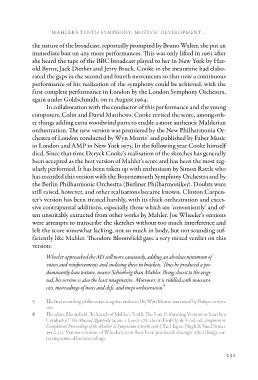Page 233 - Vinkler, Jonatan, in Jernej Weiss. ur. 2014. Musica et Artes: ob osemdesetletnici Primoža Kureta. Koper: Založba Univerze na Primorskem.
P. 233
mahler’s tenth symphony: motivic development ...
the nature of the broadcast, reportedly prompted by Bruno Walter, she put an
immediate ban on any more performances. This was only lifted in 1963 after
she heard the tape of the BBC broadcast played to her in New York by Har-
old Byrns, Jack Diether and Jerry Bruck. Cooke in the meantime had elabo-
rated the gaps in the second and fourth movements so that now a continuous
performance of his realisation of the symphony could be achieved, with the
first complete performance in London by the London Symphony Orchestra,
again under Goldschmidt, on 13 August 1964.
In collaboration with the conductor of this performance and the young
composers, Colin and David Matthews, Cooke revised the score, among oth-
er things adding extra woodwind parts to enable a more authentic Mahlerian
orchestration. The new version was premiered by the New Philharmonia Or-
chestra of London conducted by Wyn Morris7 and published by Faber Music
in London and AMP in New York 1975. In the following year Cooke himself
died. Since that time Deryck Cooke’s realisation of the sketches has generally
been accepted as the best version of Mahler’s score and has been the most reg-
ularly performed. It has been taken up with enthusiasm by Simon Rattle who
has recorded this version with the Bournemouth Symphony Orchestra and by
the Berlin Philharmonic Orchestra (Berliner Philharmoniker). Doubts were
still raised, however, and other realisations became known. Clinton Carpen-
ter’s version has been treated harshly, with its thick orchestration and exces-
sive contrapuntal additions, especially those which are ‘conveniently’ and of-
ten unsuitably extracted from other works by Mahler. Joe Wheeler’s versions
were attempts to transcribe the sketches without too much interference and
left the score somewhat lacking, not so much in body, but not sounding suf-
ficiently like Mahler. Theodore Bloomfield gave a very mixed verdict on this
version:
Wheeler approached the MS still more cautiously, adding an absolute minimum of
voices and reinforcements and enclosing these in brackets. Thus he produced a pre-
dominantly lean texture, nearer Schönberg than Mahler. Being closest to the origi-
nal, his version is also the least imaginative. Moreover, it is riddled with inaccura-
cies, misreadings of notes and clefs, and inept orchestration.8
7 The first recording of this version, again conducted by Wyn Morris, was issued by Philips on 6700
067.
8 Theodore Bloomfield, “In Search of Mahler’s Tenth: The Four Performing Versions as Seen by a
Conductor,” The Musical Quarterly 74, no. 2 (1990): 178; also in Paul Op de Coul, ed., Fragment or
Completion? Proceedings of the Mahler X Symposium Utrecht 1986 (The Hague: Nijgh & Van Ditmar,
1991), 113. Various revisions of Wheeler’s score have been produced, amongst other things cor-
recting some of his misreadings.
231
the nature of the broadcast, reportedly prompted by Bruno Walter, she put an
immediate ban on any more performances. This was only lifted in 1963 after
she heard the tape of the BBC broadcast played to her in New York by Har-
old Byrns, Jack Diether and Jerry Bruck. Cooke in the meantime had elabo-
rated the gaps in the second and fourth movements so that now a continuous
performance of his realisation of the symphony could be achieved, with the
first complete performance in London by the London Symphony Orchestra,
again under Goldschmidt, on 13 August 1964.
In collaboration with the conductor of this performance and the young
composers, Colin and David Matthews, Cooke revised the score, among oth-
er things adding extra woodwind parts to enable a more authentic Mahlerian
orchestration. The new version was premiered by the New Philharmonia Or-
chestra of London conducted by Wyn Morris7 and published by Faber Music
in London and AMP in New York 1975. In the following year Cooke himself
died. Since that time Deryck Cooke’s realisation of the sketches has generally
been accepted as the best version of Mahler’s score and has been the most reg-
ularly performed. It has been taken up with enthusiasm by Simon Rattle who
has recorded this version with the Bournemouth Symphony Orchestra and by
the Berlin Philharmonic Orchestra (Berliner Philharmoniker). Doubts were
still raised, however, and other realisations became known. Clinton Carpen-
ter’s version has been treated harshly, with its thick orchestration and exces-
sive contrapuntal additions, especially those which are ‘conveniently’ and of-
ten unsuitably extracted from other works by Mahler. Joe Wheeler’s versions
were attempts to transcribe the sketches without too much interference and
left the score somewhat lacking, not so much in body, but not sounding suf-
ficiently like Mahler. Theodore Bloomfield gave a very mixed verdict on this
version:
Wheeler approached the MS still more cautiously, adding an absolute minimum of
voices and reinforcements and enclosing these in brackets. Thus he produced a pre-
dominantly lean texture, nearer Schönberg than Mahler. Being closest to the origi-
nal, his version is also the least imaginative. Moreover, it is riddled with inaccura-
cies, misreadings of notes and clefs, and inept orchestration.8
7 The first recording of this version, again conducted by Wyn Morris, was issued by Philips on 6700
067.
8 Theodore Bloomfield, “In Search of Mahler’s Tenth: The Four Performing Versions as Seen by a
Conductor,” The Musical Quarterly 74, no. 2 (1990): 178; also in Paul Op de Coul, ed., Fragment or
Completion? Proceedings of the Mahler X Symposium Utrecht 1986 (The Hague: Nijgh & Van Ditmar,
1991), 113. Various revisions of Wheeler’s score have been produced, amongst other things cor-
recting some of his misreadings.
231


